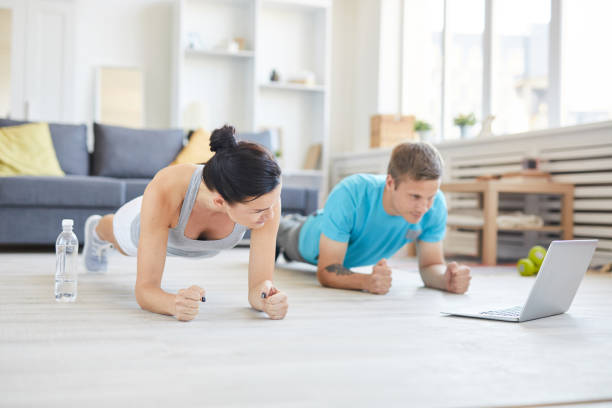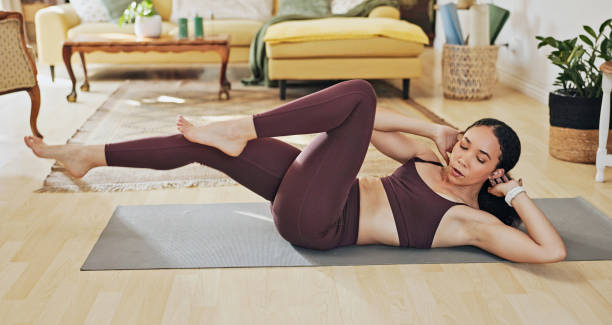Introduction
Today, we discuss fitness for beginners at home. Beginning a fitness journey is often exhilarating yet terrifying at the same time, particularly for novices. The good news is that you don’t need a gym membership or fancy equipment to get fit. As a beginner, you can exercise at home, and it’s essential to develop a plan that suits you. In this article, let’s take a look at simple workouts and actionable tips to help you jump-start your fitness journey from the comfort of your own home.
The Importance of Fitness

It is essential to maintain a regular fitness routine. Exercise also aids in weight reduction, boosts mood, increases energy levels, and clarifies the mind. Exercise regularly, which is, of course, well-known to beginners but offers better-paying convenience in the years to come, such as decreasing the risk of chronic disease and improving longevity. Understanding why fitness is essential will motivate you to incorporate it into your daily life.
Setting Realistic Goals
Setting standard fitness goals is essential before you start any workouts. First, decide on your goals — weight loss, strength, or endurance. Some of this can be guided by setting SMART goals, i.e., specific, measurable, achievable, relevant, and time-bound. Instead of “I want to get fit,” specify “I want to work out for 30 minutes, three times a week.” Ensure that your targets are attainable; this will help you stay motivated and committed to your fitness plan.
Creating a Workout Space
A dedicated workout space at home is crucial for fitness beginners. Please select an area with ample space to move around, such as a spare room, your living room, or even a balcony. This ensures a positive environment by providing a pleasant space for you to work in. Depending on what you already have, consider investing in a yoga mat, resistance bands, or small dumbbells to take your workouts to the next level. This will also ensure that you are committed to your exercise and can incorporate it into your daily life tasks.
Warm-Up Exercises
Before any workout, it’s essential to warm up your body to prepare for exercise and prevent injury. Warm-up: 5–10 minutes of light cardio and dynamic stretches to raise your heart rate and loosen up. Just a few simple warm-up exercises: Arm circles, leg swings, jumping jacks, etc. This gradually prepares your muscles and joints for movement, increasing the likelihood that you will enjoy and benefit from your workout.
Easy Cardio Workouts for Beginners
Aerobic exercises are crucial for improving heart health and burning calories. If you’re a beginner, you can also try low-impact cardio workouts that are gentle on your joints. Brisk walking, cycling, or dancing are effective ways to increase your heart rate. You can also jump rope or use an aerobic step for variety. To raise your fitness levels and build endurance, aim for at least 20-30 minutes of cardio exercise several times a week.
Strength Training Basics
Transitioning to the strength training component is necessary to build muscle and boost metabolism. If you have never worked out before, you can start with bodyweight exercises for resistance, such as push-ups, squats, and lunges. And work yourself up from one set of 8 to 12 reps as tolerated. You can also add resistance bands or light dumbbells for an extra challenge. Try to schedule strength training in your routine at least two days a week for an overall balanced level of fitness.
Flexibility and Stretching

Flexible at heart. How is flexibility a crucial component of fitness? Stretching regularly can increase your range of motion and help prevent injury. Post-workout stretching exercises can help aid recovery and relax muscles; include them in your routine—emphasize major muscle groups, including the hamstrings, quadriceps, and shoulders. Yoga also improves flexibility, and numerous classes are available online and through apps that you can complete from the comfort of your own home.
Developing a Balanced Routine
A balanced workout routine should include cardiovascular, strength training, and flexibility exercises. The trick, especially for beginners, is to find the balance between these elements that leads to overall fitness. Create a weekly workout plan that incorporates a variety of exercises. On Mondays and Wednesdays, for instance, focus on cardio; Tuesdays and Thursdays can be dedicated to strength training; Fridays can be reserved for flexibility exercises. A mixture of movements in your routine keeps your workout fun and allows you to progress effectively.
Staying Motivated
Maintaining motivation while exercising at home can be challenging, especially during a pandemic. Things like rewarding yourself for reaching your fitness goals can help keep you motivated. Give yourself little rewards, such as a nice bath or fresh workout attire, when you accomplish a goal. Consider getting a workout partner or joining online fitness communities for additional support. Sharing your journey helps keep you motivated, and accountability makes it easier to stick to your routine.
Tracking Your Progress
It’s essential to monitor your progress; the accountability will keep you motivated. Keep a fitness journal or use an easy-to-use mobile app to track your workouts, goals, and achievements. Seeing your progress enables you to understand where you stand and pinpoint areas for improvement. Take the time during your journey to celebrate the small wins, because they all add up. Tracking your journey will help you stay motivated to keep striving for your fitness goals.
Listening to Your Body
Be mindful when you start your fitness journey — listen to your body. Notice how you feel during and after workouts, and take note of any pain or discomfort you experience. If you feel sore or fatigued, consider taking the day off or doing lighter exercise. If you are truly a newbie, be cautious and don’t overdo it. You must give your body adequate time to recover, as this helps you stay injury-free and is the key to long-term success.
Making Fitness a Habit

In conclusion, progressive overload, combined with consistency, is the key to achieving your fitness goals. Try to incorporate it into your routine by doing workouts at the same time every day, so that it becomes a fitness routine for beginners at home. You might even think of your workout sessions as appointments that cannot be missed; soon enough, exercise will become a part of your daily routine. For example, if exercise becomes a part of your daily routine, it has the added benefit of creating endorphins, leading to a happier and healthier you.
Conclusion
Beginning your fitness journey at home can feel less overwhelming. It’s all about enjoying the process of getting fit for beginners at home and incorporating easy workouts into your routine to achieve your goals. Just be sure to stay focused on realistic goals, have a plan for where to exercise, and maintain a balance. With persistence and dedication, you will form long-lasting habits that support your health and well-being. So tie those sneakers, and get ready to start your fitness journey right now!

